Abstract
Consumption of alcohol causes hyperuricemia by decreasing urate excretion and increasing its production. Our previous studies indicate that ethanol administration increases uric acid production by increasing ATP degradation to uric acid precursors. To test the hypothesis that ethanol-induced increased urate production results from acetate metabolism and enhanced adenosine triphosphate turnover, we gave intravenous sodium acetate, sodium chloride and ethanol (0.1 mmol/kg per min for 1 h) to five normal subjects. Acetate plasma levels increased from 0.04 +/- 0.01 mM (mean +/- SE) to peak values of 0.35 +/- 0.07 mM and to 0.08 +/- 0.01 mM during acetate and ethanol infusions, respectively. Urinary oxypurines increased to 223 +/- 13% and 316 +/- 44% of the base-line values during acetate and ethanol infusions, respectively. Urinary radioactivity from the adenine nucleotide pool labeled with [8-14C] adenine increased to 171 +/- 27% and to 128 +/- 8% of the base-line values after acetate and ethanol infusions. These data indicate that both ethanol and acetate increase purine nucleotide degradation by enhancing the turnover of the adenine nucleotide pool. They support the hypothesis that acetate metabolism contributes to the increased production of urate associated with ethanol intake.
Full text
PDF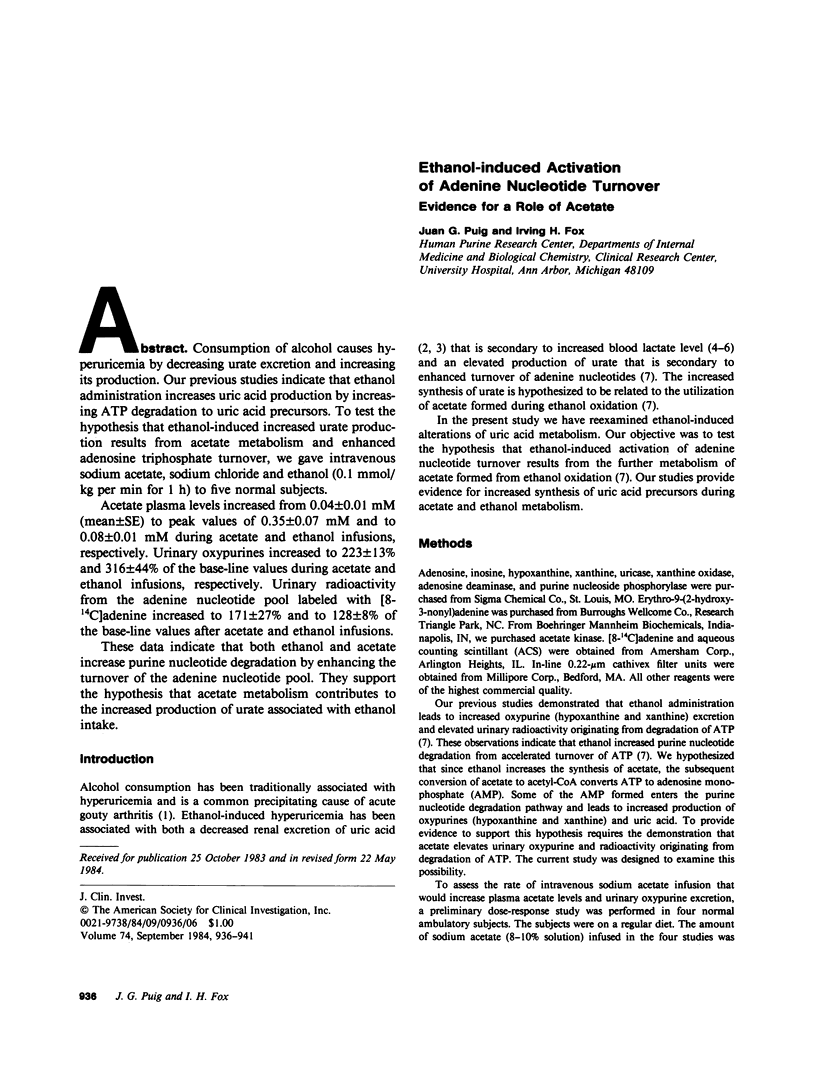
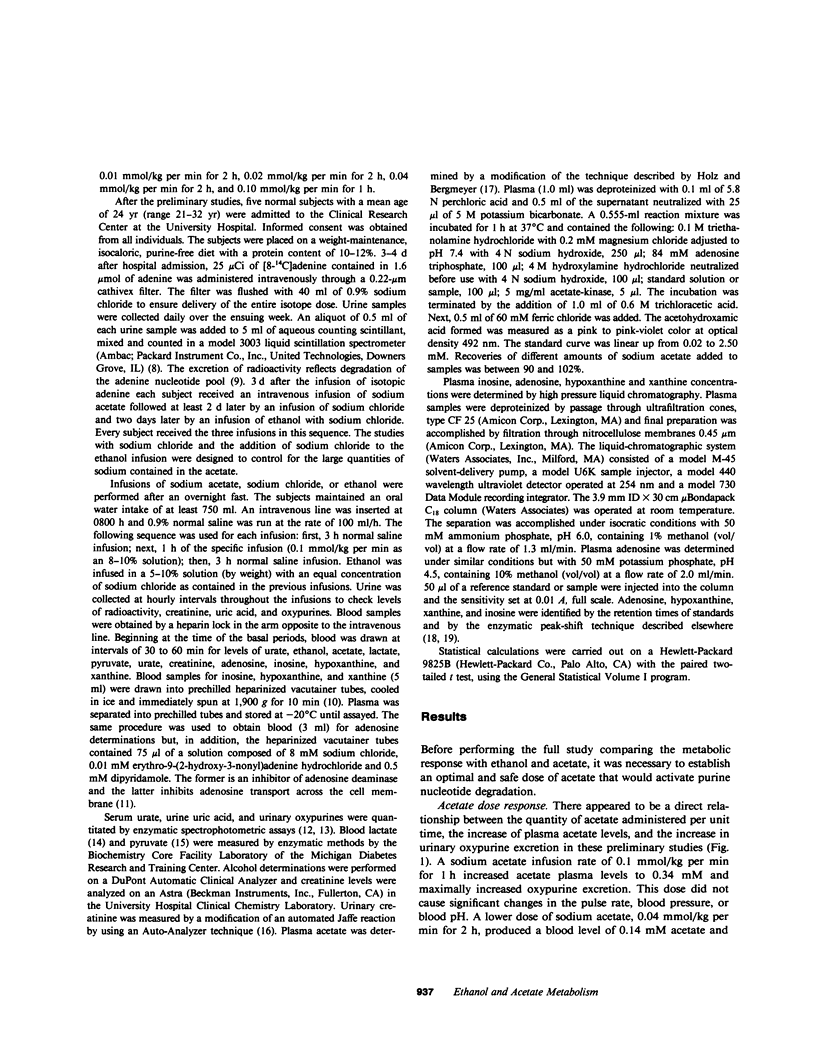
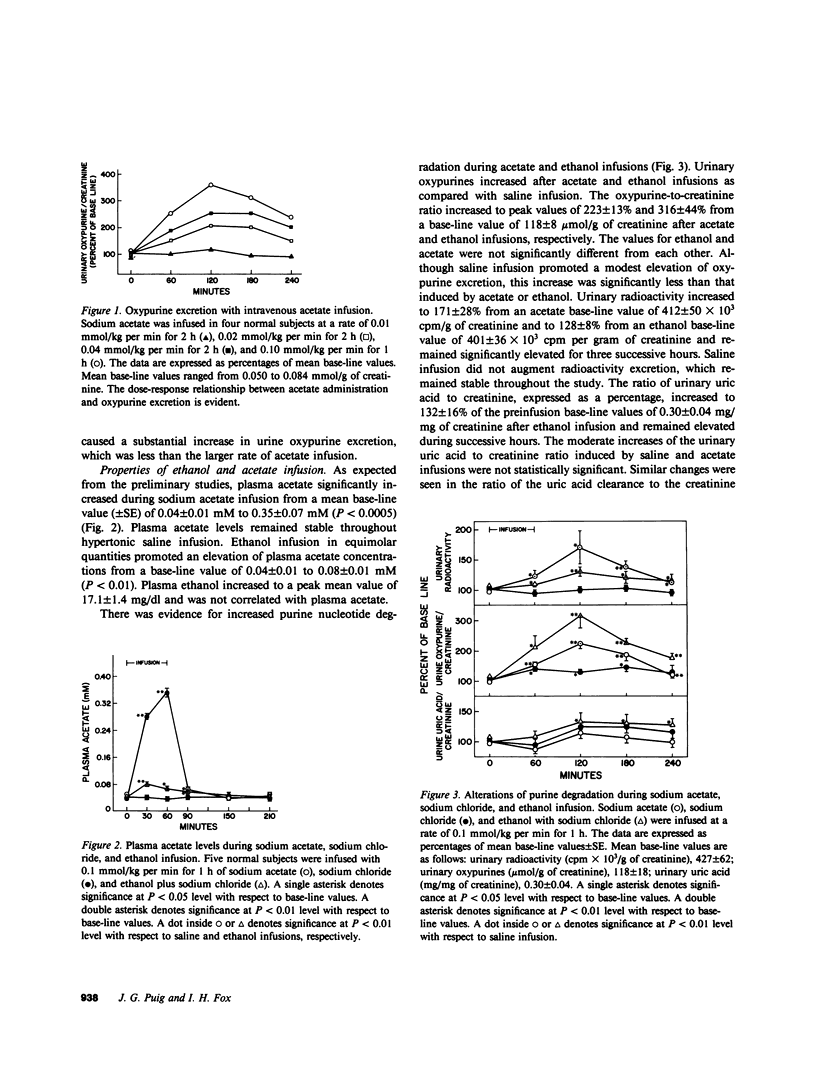
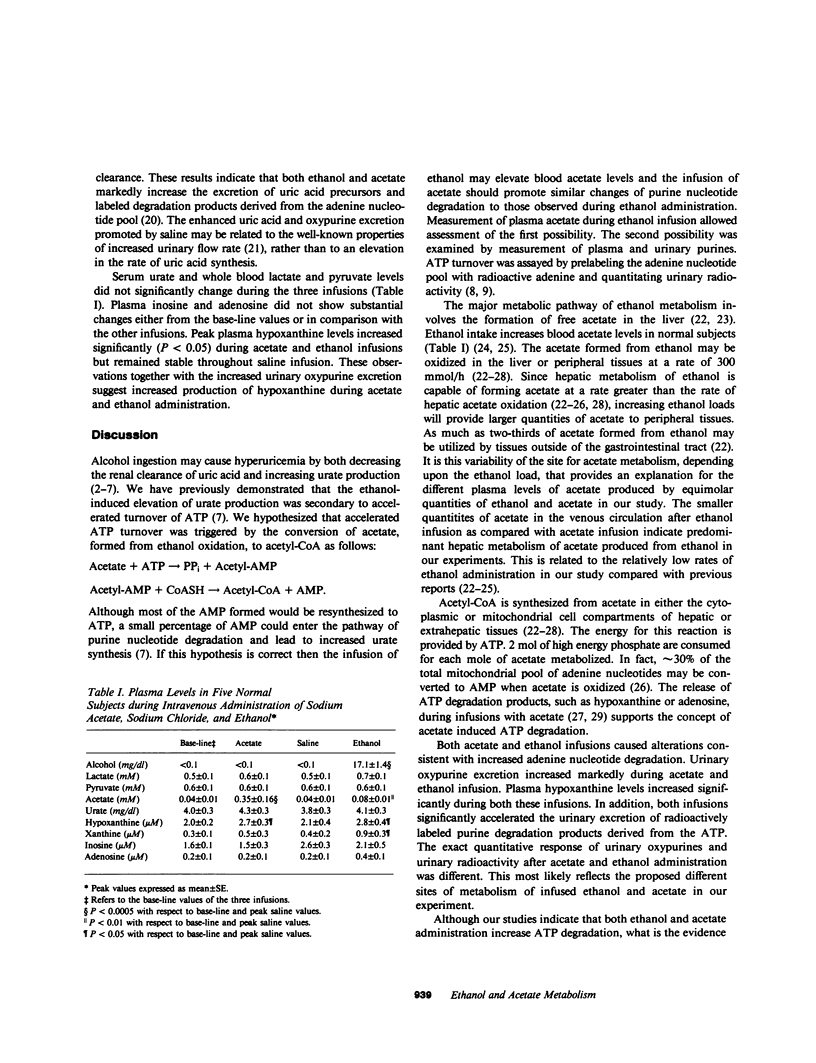
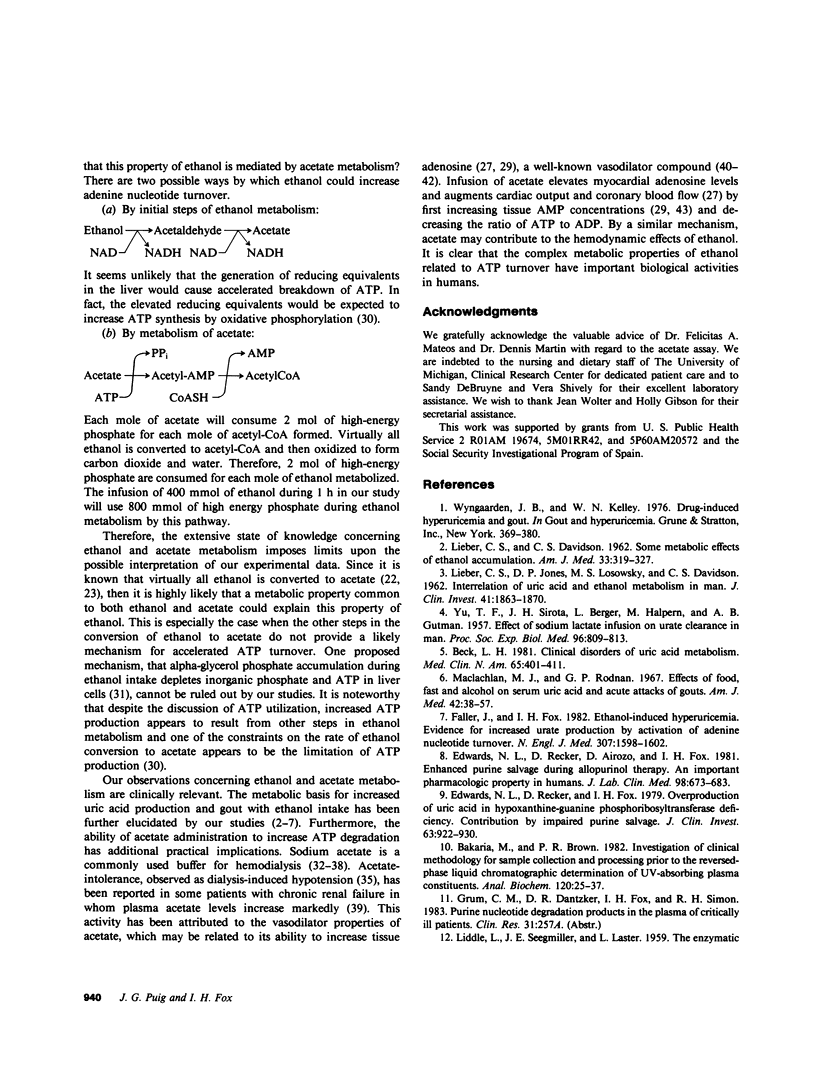
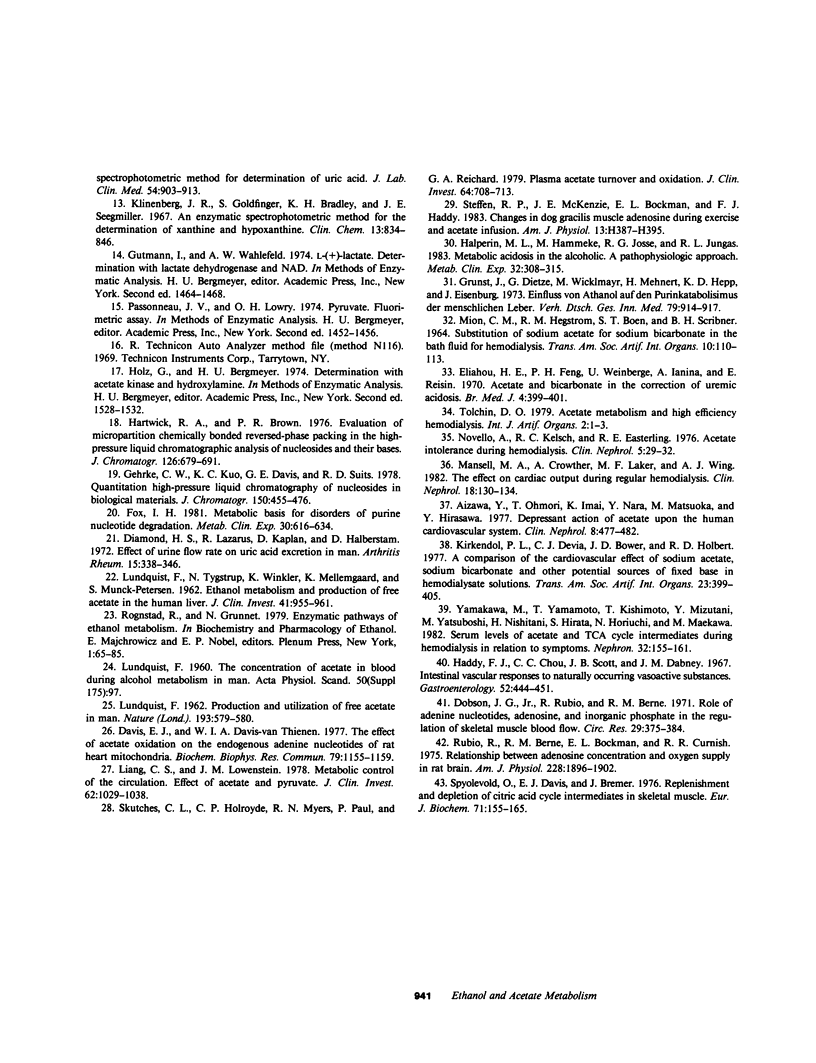
Selected References
These references are in PubMed. This may not be the complete list of references from this article.
- Aizawa Y., Ohmori T., Imai K., Nara Y., Matsuoka M., Hirasawa Y. Depressant action of acetate upon the human cardiovascular system. Clin Nephrol. 1977 Nov;8(5):477–480. [PubMed] [Google Scholar]
- Davis E. J., Davis-van Thienen W. I. The effect of acetate oxidation on the endogenous adenine nucleotides of rat heart mitochondria. Biochem Biophys Res Commun. 1977 Dec 21;79(4):1155–1159. doi: 10.1016/0006-291x(77)91127-5. [DOI] [PubMed] [Google Scholar]
- Diamond H. S., Lazarus R., Kaplan D., Halberstam D. Effect of urine flow rate on uric acid excretion in man. Arthritis Rheum. 1972 Jul-Aug;15(4):338–346. doi: 10.1002/art.1780150403. [DOI] [PubMed] [Google Scholar]
- Dobson J. G., Jr, Rubio R., Berne R. M. Role of adenine nucleotides, adenosine, and inorganic phosphate in the regulation of skeletal muscle blood flow. Circ Res. 1971 Oct;29(4):375–384. doi: 10.1161/01.res.29.4.375. [DOI] [PubMed] [Google Scholar]
- Edwards N. L., Recker D., Airozo D., Fox I. H. Enhanced purine salvage during allopurinol therapy: an important pharmacologic property in humans. J Lab Clin Med. 1981 Nov;98(5):673–683. [PubMed] [Google Scholar]
- Edwards N. L., Recker D., Fox I. H. Overproduction of uric acid in hypoxanthine-guanine phosphoribosyltransferase deficiency. Contribution by impaired purine salvage. J Clin Invest. 1979 May;63(5):922–930. doi: 10.1172/JCI109392. [DOI] [PMC free article] [PubMed] [Google Scholar]
- Eliahou H. E., Feng P. H., Weinberg U., Iaina A., Reisin E. Acetate and bicarbonate in the correction of uraemic acidosis. Br Med J. 1970 Nov 14;4(5732):399–401. doi: 10.1136/bmj.4.5732.399. [DOI] [PMC free article] [PubMed] [Google Scholar]
- Faller J., Fox I. H. Ethanol-induced hyperuricemia: evidence for increased urate production by activation of adenine nucleotide turnover. N Engl J Med. 1982 Dec 23;307(26):1598–1602. doi: 10.1056/NEJM198212233072602. [DOI] [PubMed] [Google Scholar]
- Fox I. H. Metabolic basis for disorders of purine nucleotide degradation. Metabolism. 1981 Jun;30(6):616–634. doi: 10.1016/0026-0495(81)90142-6. [DOI] [PubMed] [Google Scholar]
- Gehrke C. W., Kuo K. C., Davis G. E., Suits R. D., Waalkes T. P., Borek E. Quantitative high-performance liquid chromatography of nucleosides in biological materials. J Chromatogr. 1978 Mar 21;150(2):455–476. doi: 10.1016/s0021-9673(00)88205-9. [DOI] [PubMed] [Google Scholar]
- Grunst J., Dietze G., Wicklmayr M., Mehnert H., Hepp K. D., Eisenburg J. Einfluss von Athanol auf den Purinkatabolismus der menschlichen Leber. Verh Dtsch Ges Inn Med. 1973;79:914–917. [PubMed] [Google Scholar]
- Haddy F. J., Chou C. C., Scott J. B., Dabney J. M. Intestinal vascular responses to naturally occurring vasoactive substances. Gastroenterology. 1967 Feb;52(2):444–451. [PubMed] [Google Scholar]
- Halperin M. L., Hammeke M., Josse R. G., Jungas R. L. Metabolic acidosis in the alcoholic: a pathophysiologic approach. Metabolism. 1983 Mar;32(3):308–315. doi: 10.1016/0026-0495(83)90197-x. [DOI] [PubMed] [Google Scholar]
- Hartwick R. A., Brown P. R. Evaluation of microparticle chemically bonded reversed-phase packings in the high-pressure liquid chromatographic analysis of nucleosides and their bases. J Chromatogr. 1976 Nov 3;126:679–691. doi: 10.1016/s0021-9673(01)84111-x. [DOI] [PubMed] [Google Scholar]
- Kirkendol P. L., Devia C. J., Bower J. D., Holbert R. D. A comparison of the cardiovascular effects of sodium acetate, sodium bicarbonate and other potential sources of fixed base in hemodialysate solutions. Trans Am Soc Artif Intern Organs. 1977;23:399–405. doi: 10.1097/00002480-197700230-00103. [DOI] [PubMed] [Google Scholar]
- Klinenberg J. R., Goldfinger S., Bradley K. H., Seegmiller J. E. An enzymatic spectrophotometric method for the determination of xanthine and hypoxanthine. Clin Chem. 1967 Oct;13(10):834–846. [PubMed] [Google Scholar]
- LIDDLE L., SEEGMILLER J. E., LASTER L. The enzymatic spectrophotometric method for determination of uric acid. J Lab Clin Med. 1959 Dec;54:903–913. [PubMed] [Google Scholar]
- LIEBER C. S., DAVIDSON C. S. Some metabolic effects of ethyl alcohol. Am J Med. 1962 Sep;33:319–327. doi: 10.1016/0002-9343(62)90229-2. [DOI] [PubMed] [Google Scholar]
- LIEBER C. S., JONES D. P., LOSOWSKY M. S., DAVIDSON C. S. Interrelation of uric acid and ethanol metabolism in man. J Clin Invest. 1962 Oct;41:1863–1870. doi: 10.1172/JCI104643. [DOI] [PMC free article] [PubMed] [Google Scholar]
- LUNDQUIST F. Production and utilization of free acetate in man. Nature. 1962 Feb 10;193:579–580. doi: 10.1038/193579b0. [DOI] [PubMed] [Google Scholar]
- LUNDQUIST F., TYGSTRUP N., WINKLER K., MELLEMGAARD K., MUNCK-PETERSEN S. Ethanol metabolism and production of free acetate in the human liver. J Clin Invest. 1962 May;41:955–961. doi: 10.1172/JCI104574. [DOI] [PMC free article] [PubMed] [Google Scholar]
- Liang C. S., Lowenstein J. M. Metabolic control of the circulation. Effects of acetate and pyruvate. J Clin Invest. 1978 Nov;62(5):1029–1038. doi: 10.1172/JCI109207. [DOI] [PMC free article] [PubMed] [Google Scholar]
- Maclachlan M. J., Rodnan G. P. Effect of food, fast and alcohol on serum uric acid and acute attacks of gout. Am J Med. 1967 Jan;42(1):38–57. doi: 10.1016/0002-9343(67)90005-8. [DOI] [PubMed] [Google Scholar]
- Mansell M. A., Crowther A., Laker M. F., Wing A. J. The effect of hyperacetatemia on cardiac output during regular hemodialysis. Clin Nephrol. 1982 Sep;18(3):130–134. [PubMed] [Google Scholar]
- Novello A., Kelsch R. C., Easterling R. E. Acetate intolerance during hemodialysis. Clin Nephrol. 1976 Jan;5(1):29–32. [PubMed] [Google Scholar]
- Rubio R., Berne R. M., Bockman E. L., CURNISH R. R. Relationship between adenosine concentration and oxygen supply in rat brain. Am J Physiol. 1975 Jun;228(6):1896–1902. doi: 10.1152/ajplegacy.1975.228.6.1896. [DOI] [PubMed] [Google Scholar]
- Skutches C. L., Holroyde C. P., Myers R. N., Paul P., Reichard G. A. Plasma acetate turnover and oxidation. J Clin Invest. 1979 Sep;64(3):708–713. doi: 10.1172/JCI109513. [DOI] [PMC free article] [PubMed] [Google Scholar]
- Spydevold S., Davis E. J., Bremer J. Replenishment and depletion of citric acid cycle intermediates in skeletal muscle. Indication of pyruvate carboxylation. Eur J Biochem. 1976 Dec;71(1):155–165. doi: 10.1111/j.1432-1033.1976.tb11101.x. [DOI] [PubMed] [Google Scholar]
- Steffen R. P., McKenzie J. E., Bockman E. L., Haddy F. J. Changes in dog gracilis muscle adenosine during exercise and acetate infusion. Am J Physiol. 1983 Mar;244(3):H387–H395. doi: 10.1152/ajpheart.1983.244.3.H387. [DOI] [PubMed] [Google Scholar]
- Tolchin N. Acetate metabolism and high efficiency hemodialysis. Int J Artif Organs. 1979 Jan;2(1):1–3. [PubMed] [Google Scholar]
- YU T. F., SIROTA J. H., BERGER L., HALPERN M., GUTMAN A. B. Effect of sodium lactate infusion on urate clearance in man. Proc Soc Exp Biol Med. 1957 Dec;96(3):809–813. doi: 10.3181/00379727-96-23616. [DOI] [PubMed] [Google Scholar]
- Yamakawa M., Yamamoto T., Kishimoto T., Mizutani Y., Yatsuboshi M., Nishitani H., Hirata S., Horiuchi N., Maekawa M. Serum levels of acetate and TCA cycle intermediates during hemodialysis in relation to symptoms. Nephron. 1982;32(2):155–161. doi: 10.1159/000182836. [DOI] [PubMed] [Google Scholar]
- Zakaria M., Brown P. R. Investigation of clinical methodology for sample collection and processing prior to the reversed-phase liquid chromatographic determination of UV-absorbing plasma constituents. Anal Biochem. 1982 Feb;120(1):25–37. doi: 10.1016/0003-2697(82)90313-x. [DOI] [PubMed] [Google Scholar]


